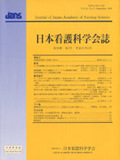Japanese
English
- 販売していません
- Abstract 文献概要
- 参考文献 Reference
要旨
先天性心疾患患者の小児期におけるボディイメージの形成過程を明らかにすることを目的に,グラウンデッド・セオリー・アプローチを用いて分析した.
先天性心疾患をもつ21名の成人患者に,小児期における身体に対する思いを回想してもらった.ボディイメージの形成過程は,もの心ついた時に認識した身体に対するあたりまえさを自分なりのあたりまえさに再構築していく『あたりまえさの創造』であった.【もの心ついたときのあたりまえさ】を基盤にし,友だち社会に進出して認識した身体心理社会的な【不都合さの実感】を,【同化への試み】【ジレンマとの駆け引き】【体内の調整力の発揮】をしながら,【自分らしいあたりまえさの再構築】へと変化修正させていた.体内感覚を頼りにしたボディイメージは,社会的営みを通して自己イメージへと創造されており,身体の適切な理解,他者からの了解,安心,コントロール感の獲得,他者との共軛,理想像との一体感,適応の実感を高めることが安定した自己構築につながると考えられた.
Abstract
The purpose of this study was to clarify the process through which children with congenital heart disease (CHD) construct a body-image throughout their childhood. The research participants were 21 persons with CHD. The subjects were asked about their childhood recollections regarding their bodies. The taped and transcribed interview data was analyzed using a grounded theory approach.
It was found that the construction of body-image was a process of “creation of a natural sense,” involving a reconstruction of one's own natural sense from one's earliest recollections. This process was based in the “natural sense of one's earliest recollections.” When the subjects began moving into their peer groups, they found that their bodily sense was a new physical-mental-social experience of “experiencing dissatisfaction,” followed by a process of “attempting to assimilate,” “struggling with a dilemma,” and “exercising an embodied power of adjustment,” which was changed and modified into a “reconstruction of one's own natural sense.” The subjects created a self-image through their social life depending on a body-image based on an internal sense of their own body. It was suggested that in order for a child to develop a stable sense of self, it was necessary to understand one's own body appropriately, to be accepted by others, to gain a feeling of relief, to attain a sense of control, to carry out interactions with others, to move closer to one's own ideal image, and to have a feeling that one can adapt to the environment.
Copyright © 2009, Japan Academy of Nursing Science. All rights reserved.


